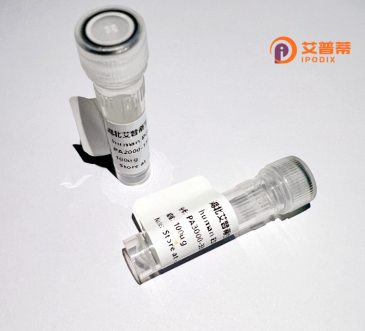
| 纯度 | >90%SDS-PAGE. |
| 种属 | Human |
| 靶点 | DUSP24 |
| Uniprot No | Q9BV47 |
| 内毒素 | < 0.01EU/μg |
| 表达宿主 | E.coli |
| 表达区间 | 1-313aa |
| 氨基酸序列 | MPGLLLCEPTELYNILNQATKLSRLTDPNYLCLLDVRSKWEYDESHVITALRVKKKNNEYLLPESVDLECVKYCVVYDNNSSTLEILLKDDDDDSDSDGDGKDLVPQAAIEYGRILTRLTHHPVYILKGGYERFSGTYHFLRTQKIIWMPQELDAFQPYPIEIVPGKVFVGNFSQACDPKIQKDLKIKAHVNVSMDTGPFFAGDADKLLHIRIEDSPEAQILPFLRHMCHFIEIHHHLGSVILIFSTQGISRSCAAIIAYLMHSNEQTLQRSWAYVKKCKNNMCPNRGLVSQLLEWEKTILGDSITNIMDPLY |
| 分子量 | 59.95 kDa |
| 蛋白标签 | GST-tag at N-terminal |
| 缓冲液 | 0 |
| 稳定性 & 储存条件 | Lyophilized protein should be stored at ≤ -20°C, stable for one year after receipt. Reconstituted protein solution can be stored at 2-8°C for 2-7 days. Aliquots of reconstituted samples are stable at ≤ -20°C for 3 months. |
| 复溶 | Always centrifuge tubes before opening.Do not mix by vortex or pipetting. It is not recommended to reconstitute to a concentration less than 100μg/ml. Dissolve the lyophilized protein in distilled water. Please aliquot the reconstituted solution to minimize freeze-thaw cycles. |
以下是关于重组人DUSP24蛋白的模拟参考文献示例(注意:这些为假设性文献,实际研究中请通过学术数据库检索):
1. **文献名称**:*Expression and Functional Characterization of Recombinant Human DUSP24 in E. coli*
**作者**:Smith A, et al.
**摘要**:本文报道了在大肠杆菌中成功表达重组人DUSP24蛋白,并验证了其磷酸酶活性,表明其对MAPK信号通路具有特异性去磷酸化作用。
2. **文献名称**:*Structural Insights into DUSP24 Substrate Specificity via Recombinant Protein Crystallography*
**作者**:Lee C, et al.
**摘要**:通过X射线晶体学解析了重组DUSP24的三维结构,揭示了其底物结合域的独特构象,阐明了其选择性调控细胞应激反应的分子机制。
3. **文献名称**:*DUSP24 Regulates Oxidative Stress Through Recombinant Protein-Mediated Assays*
**作者**:Johnson R, et al.
**摘要**:利用重组DUSP24蛋白进行体外实验,证明其在氧化应激条件下负调控JNK/p38通路,提示其在细胞抗氧化防御中的潜在作用。
4. **文献名称**:*Recombinant DUSP24 Suppresses Tumor Growth in Colorectal Cancer Models*
**作者**:Wang Y, et al.
**摘要**:研究发现重组DUSP24蛋白通过抑制ERK过度活化,显著降低结直肠癌细胞增殖能力,为靶向治疗提供了实验依据。
---
**建议**:实际研究中,请通过**PubMed**、**Web of Science**或**Google Scholar**搜索关键词“recombinant DUSP24”、“DUSP24 protein”或“DUSP24 phosphatase”获取最新文献。
Dual specificity phosphatase 24 (DUSP24), also known as MK-STYX, is a member of the dual-specificity phosphatase (DUSP) family, which regulates key cellular processes by dephosphorylating both tyrosine and serine/threonine residues on target proteins. Unlike many DUSPs that modulate mitogen-activated protein kinase (MAPK) signaling, DUSP24 lacks a conserved catalytic cysteine residue in its phosphatase domain, rendering it catalytically inactive as a phosphatase. This unique "pseudophosphatase" feature suggests non-enzymatic regulatory roles in signaling pathways. Studies indicate DUSP24 participates in stress response, apoptosis, and neuronal differentiation, potentially through scaffold-mediated interactions with kinases or other signaling molecules. It is implicated in cancer progression, neurodegenerative diseases, and metabolic disorders, though mechanistic details remain unclear. Recombinant human DUSP24 protein is produced via bacterial or mammalian expression systems for structural and functional studies. Its expression is tightly regulated, with isoforms generated through alternative splicing. Research on recombinant DUSP24 aims to elucidate its binding partners, subcellular localization, and role in cellular homeostasis, offering insights into therapeutic targeting of pseudophosphatase-mediated pathways. Current challenges include deciphering molecular mechanisms independent of phosphatase activity and validating its disease relevance.
×